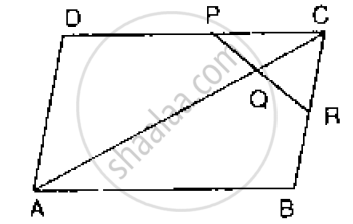Advertisements
Advertisements
प्रश्न
In the given figure, ΔABC is an equilateral traingle. Points F, D and E are midpoints of side AB, side BC, side AC respectively. Show that ΔFED is an equilateral traingle.

उत्तर
Given: ∆ABC is an equilateral triangle and D, E and F are mid-points of BC, AC and AB respectively.
To prove: ∆FED is an equilateral triangle.
Proof:
In ΔABC,
Points F and E are the midpoints of sides AB and AC respectively. ...(Given)
∴ FE = `1/2` BC ...(From midpoint theorem) ...(i)
In ΔABC,
Points D and E are the midpoints of sides BC and AC respectively. ...(Given)
∴ DE = `1/2` AB ...(From midpoint theorem) ...(ii)
In ΔABC,
Points D and F are the midpoints of sides BC and AB respectively. ...(Given)
∴ DF = `1/2` AC ...(From midpoint theorem) ...(iii)
Now, ΔABC is an equilateral triangle.
∴ BC = AB = AC ...(Sides of equilateral triangle)
∴ `1/2` BC = `1/2` AB = `1/2` AC ...(Multiplying both sides by `1 /2`)
∴ FE = DE = DF ...[From (i), (ii) and (iii)]
∴ ΔFED is an equilateral triangle.
APPEARS IN
संबंधित प्रश्न
In below Fig, ABCD is a parallelogram in which P is the mid-point of DC and Q is a point on AC such that CQ = `1/4` AC. If PQ produced meets BC at R, prove that R is a mid-point of BC.

Show that the line segments joining the mid-points of the opposite sides of a quadrilateral
bisect each other.
A parallelogram ABCD has P the mid-point of Dc and Q a point of Ac such that
CQ = `[1]/[4]`AC. PQ produced meets BC at R.

Prove that
(i)R is the midpoint of BC
(ii) PR = `[1]/[2]` DB
The side AC of a triangle ABC is produced to point E so that CE = AC. D is the mid-point of BC and ED produced meets AB at F. Lines through D and C are drawn parallel to AB which meet AC at point P and EF at point R respectively.
Prove that:
- 3DF = EF
- 4CR = AB
If the quadrilateral formed by joining the mid-points of the adjacent sides of quadrilateral ABCD is a rectangle,
show that the diagonals AC and BD intersect at the right angle.
The quadrilateral formed by joining the mid-points of the sides of a quadrilateral PQRS, taken in order, is a rhombus, if ______.
The figure obtained by joining the mid-points of the sides of a rhombus, taken in order, is ______.
D and E are the mid-points of the sides AB and AC of ∆ABC and O is any point on side BC. O is joined to A. If P and Q are the mid-points of OB and OC respectively, then DEQP is ______.
P, Q, R and S are respectively the mid-points of the sides AB, BC, CD and DA of a quadrilateral ABCD such that AC ⊥ BD. Prove that PQRS is a rectangle.
E is the mid-point of a median AD of ∆ABC and BE is produced to meet AC at F. Show that AF = `1/3` AC.
